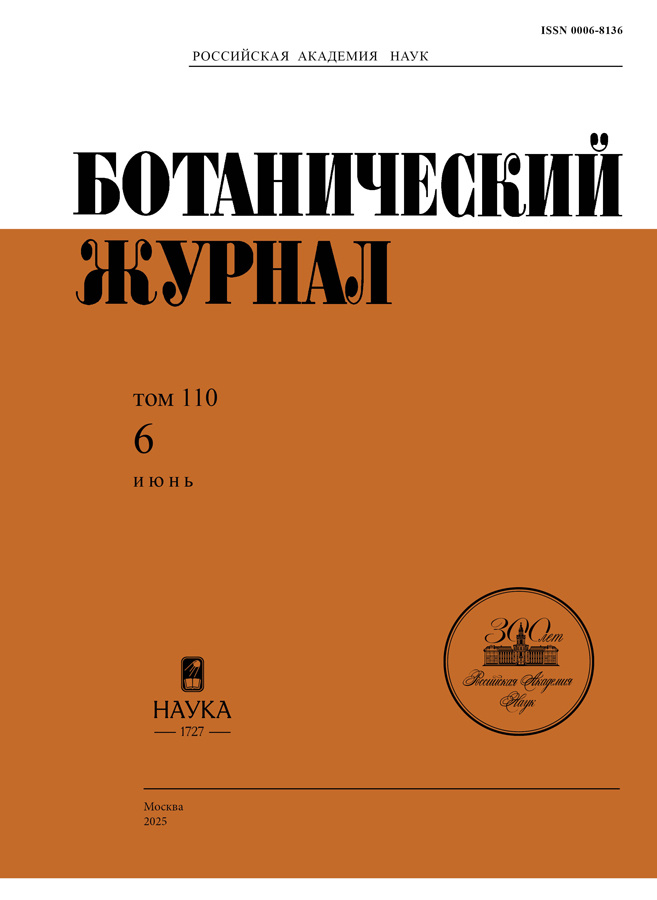Volume 110, Nº 6 (2025)
- Ano: 2025
- Artigos: 9
- URL: https://rjeid.com/0006-8136/issue/view/13801
Edição completa
COMMUNICATIONS
Bryoflora of ancient manor parks of the Orel region
Resumo
Cultural and historical heritage sites, including ancient parks, are of great importance for preserving the biodiversity of natural zonal communities. The degree of bryological study of such valuable objects in Russia cannot be considered high. The aim of this work is to identify the biodiversity of bryophytes in ancient manor parks of the Orel Region. In 2015–2024, a bryological survey of ancient manor parks in the Orel Region was conducted. The list of identified species (127) is given, specifying their occurrence, anthropogenic stability, population status, preferences of substrates, types of landscapes, and localities. The richness of moss species in the Oryol Region parks is higher than in the parks of the Central Chernozem region. The bryoflora of the parks is dominated by hemerophobous species with a low occurrence (69%) and an unsatisfactory state of populations (66%). The largest number of species grow on soil – 68, about equally on woody (50) and rocky (48) substrates; most of the species grow in natural landscapes of the landscape parks. The presence of rare and indicator species in the bryoflora (10 species from the main and 13 from the monitoring lists of the Red Book of the Orel Region) confirms an important role of ancient manor parks in preserving the biodiversity of bryophytes in the south of the broadleaf forest zone and the forest-steppe. For each studied object, information is provided on its historical owners, the share of natural landscapes, the degree of preservation of manor complexes, their historical and scientific value; bryological parameters are indicated. Based on a comprehensive analysis, 10 most valuable sites were identified: Lomtsy, Davydovka, Stepanovka, Muratovo, Korsakovo, Pervyi Voin, Drobyshevo, Progress, Mikhaylovka, and Mokhovoye. It is advisable to organize the protection of the listed manor parks as objects of landscape art.
 511–534
511–534


Diatoms of the Kilmez river (Udmurt Republic)
Resumo
This electron microscopy study of materials from the Kilmez River provided the first data on Bacillariophyta – 116 species and varieties, including 2 species new to the flora of Russia (Diploneis helvetica, Hippodonta olofjarlmanii). The highest species richness was recorded in the genera Navicula (14 species), Nitzschia and Sellaphora (8 each), Amphora (7). The obtained data expanded the taxonomic spectrum of diatom algae of the flora of the Udmurt Republic at the levels of species and genera.
 535–541
535–541


New and forgotten records of orchids (orchidaceae) for several regions of Russia. III
Resumo
In the course of the final stage of the Mapping of Russian Orchids project, we have discovered a number of orchids new to several regions of Russia. The findings were made mostly when revising old herbarium collections. In this article, we publish data on the records of Coeloglossum viride in the Lipetsk Region, Corallorhiza trifida in the Samara Region, Cypripedium guttatum in the Kursk Region (the latter is based on the old literature records dated back to 1826), Epipactis purpurata in the Voronezh Region, Herminium monorchis in the Arkhangelsk Region, Neotinea ustulata in the Republic of Adygeya, Orchis militaris in the Rostov Region. Also we report the records of taxa which were discovered in the regions of Russia for the second time.
 542–547
542–547


FLORISTIC RECORDS
New lichen species in the Flora of Sakhalin Island
Resumo
New data on 5 lichen species from Sakhalin Island are presented in the article. The five species, namely Anisomeridium polypori, Candelariella lutella, Lecidea erythrophaea, Rinodina dolichospora and Trapeliopsis flexuosa, are reported for the first time for the Sakhalin Island and the Sakhalin Region. Brief information on distribution, ecology and distinctive features from similar species is provided.
 548–552
548–552


Additions to the lichen flora of the tula region. II
Resumo
The article presents the results of field research in 2023–2024 as well as the study of herbarium materials including a revision of some specimens collected by A.V. Gudovicheva in 2013–2015. Aspicilia contorta var. viridula is recorded for the first time in Russia. A full description of this taxon, which probably is a separate species of the genus Circinaria, is provided. The other 12 species are new and rare for the Tula Region: Blennothallia crispa, Bryoria capillaris, B. nadvornikiana, B. vrangiana, Cladonia acuminata, Dibaeis baeomyces, Psevdeverinia furfuracea, Psilolechia clavulifera, Usnea dasopoga, U. glabrescens var. fulvoreagens, U. perplexans, and U. subfloridana. The updated list of lichen flora of the Tula Region comprises 366 taxa.
 553–560
553–560


Tulipa Sylvestris (Liliaceae), a new species to the flora of the Ryazan region (European
Resumo
Information on two local populations of Tulipa sylvestris, a species new for the flora of the Ryazan Region, is presented. In both localities, the species was recorded in 2023 and 2024 in the meadows of the right-bank floodplain of the Oka River in the Rybnovsky district. At least 900 specimens of different ages, including 250 flowering plants were recorded near Fedyakino village. Five small groups (50–100 m2) were found near Perekal village; the total number of specimens is more than 3.500, including about 400 flowering plants. The bulbs could have spread during the flood upstream, from the Moscow Region. New finds in the region are possible.
 561–565
561–565


PROTECTION OF PLANT WORLD
Records of new and protected vascular plant species in the Republic of Tatarstan
Resumo
Information is provided on 4 newly recorded species of vascular plants in the flora of the Republic of Tatarstan: Cerastium davuricum Fisch. ex Spreng., Cuscuta approximata Bab., Lunaria rediviva L., Saussurea amara (L.) DC.; data on the distribution and newly revealed localities of 11 more species listed in the Red Data Book of the Russian Federation is provided.
 566–570
566–570


ИСТОРИЯ НАУКИ
75ᵗʰ Anniversary of Tashkent Botanical Garden
 571–579
571–579


JUBILEES AND MEMORIAL DATES
Leonid Vladimirovich Averyanov. On his 70th anniversary
 580–614
580–614












